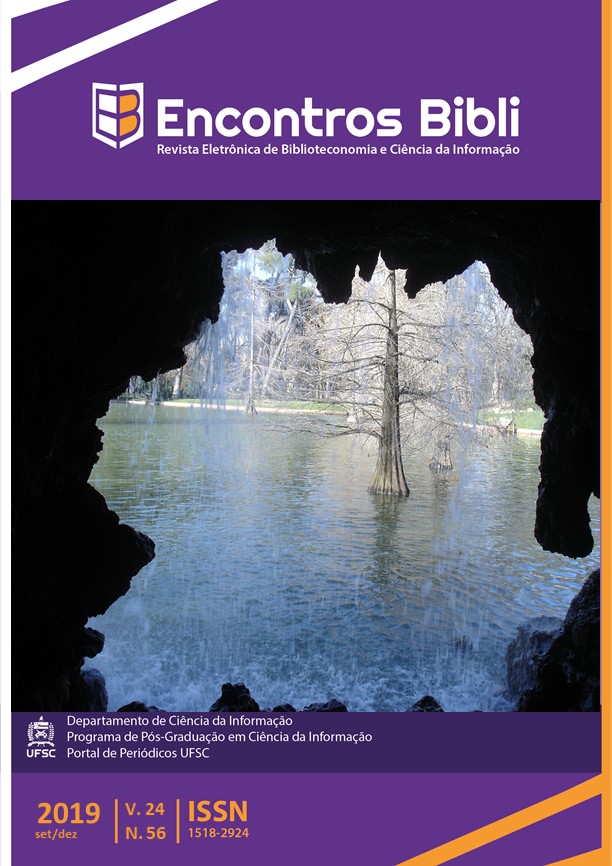Arte rupestre en Colombia: análisis cienciométrico
DOI:
https://doi.org/10.5007/1518-2924.2019.e63236Palabras clave:
Arte rupestre, Modelo de Bass, Cientometria, ColômbiaResumen
Objetivo: Analisa a literatura sobre a arte rupestre colombiana com a aplicação do modelo de difusão das inovações de Bass (1969).
Método: Reunió los documentos publicados sobre este asunto con múltiples combinaciones de búsquedas con el uso de palabras en clave en español e inglés en bases de datos bibliográficas, repositorios y catálogos de bibliotecas. Las referencias bibliográficas que se encontraron se exportaron a una base de datos bibliográfica diseñada en EndNote (Versión X8). El análisis de los datos se realizó con Microsoft Excel para obtener la demografía de la literatura y se utilizó el modelo de Bass (1969) para hallar la tasa de adoptantes de esta literatura.
Resultado: 303 publicações produzidas por 217 autores diferentes, amplamente usado em vários tipos de documentos de 1853 até Novembro de 2018. A literatura na arte da rocha colombiano ter espalhado sob a forma de artigos (34%), a informação disponível sobre as páginas da web encontrado (19%) e livros (17%) escritos principalmente em espanhol (80%). O coeficiente de inovação p (0,194%) mostra que os adotantes deste tema de pesquisa possuem um fraco fator de influência externa. O coeficiente de imitação q (24,8162%) mostra que o fator de influência interna tem um impacto importante sobre os adotantes de publicações sobre o tema. A taxa de adoção da literatura sobre a arte rupestre está no seu ponto mais alto por volta do ano 2049.
Conclusões: O modelo Baixo estima que, quando este tema de pesquisa atinge 923 pesquisadores que escrevem e publicam sobre esta questão, esta questão será alcançado maturidade e começará a declinar, ou transformar.
Descargas
Citas
ANCÍZAR, M. Peregrinación de Alpha: por las provincias del norte de la Nueva Granada, en 1850. Bogotá: Echeverria Hermanos, 1853.
ARGUELLO G., P.M. y BOTIVA CONTRERAS, Á. El arte rupestre en Colombia. Revista La Tadeo, Bogotá, n. 68, 2003.
BALLESTAS RINCÓN, L.H. El lenguaje simbólico de las formas precolombinas. Boletín Cultural y Bibliográfico, Bogotá, v. 36, n. 52, p. 2-19, 1999.
BARACALDO EUSE, J.A. Hacedores de pictografías: algunas reflexiones en torno al arte rupestre en el cercado de Facatativá al Occidente de la Sabana de Bogotá (artículo preliminar del estado de la investigación). Revista Inversa, Bogotá, v. 2, n. 1, p. 108-142, 2006.
Bass, F.M. A new product growth model for consumer durables. Management Science, Englewood Cliffs, N.J., v. 13, n. 5, p. 215-227, 1969.
CABRERA ORTIZ, W. Pictógrafos y petroglifos de Nariño. Revista de la Academia Colombiana de Ciencias Exactas, Físicas y Naturales, Bogotá, v. 12, n. 48, p. 391-400, 1966.
CADAVID HIGUITA, L.; AWAD, G.; FRANCO CARDONA, C.J. Análisis bibliométrico del campo modelado de difusión de innovaciones. Estudios Gerenciales: Journal of Management and Economics for Iberoamerica, Cali, n. 28, p. 213-236, 2012.
COMBA GONZÁLEZ, J.L. Suamox: símbolos visuales. Bogotá: Fundación Universitaria del Área Andina, 2018.
CUERVO, L.A. Los Jeroglíficos de Boyacá. Bogotá. Boletín de Historia y Antigüedades, Bogotá, n. 6, 1911.
DUQUENSE, J.D. Disertación sobre el origen del calendario y jeroglíficos de Las Moscas. Papel Periódico Ilustrado, Bogotá, n. 3, 15 MAYO de 1884.
FIGUEIREDO, J.C.B.D. Estudo da difusão da tecnologia móvel celular no Brasil: uma abordagem com o uso de Dinâmica de Sistemas. Production, São Paulo, SP, v. 19, n. 1, p. 230-245, 2009.
*FOURT, L.A.; WOODLOCK, J.W. Early prediction of market success for newqQrocery products. Journal of Marketing, New York, v. 26, n. 2, 1960. Citado por ISMAIL AND ABU (2013).
GIRON, L.M. Las Piedras Grabadas de Chinauta y Anacuta: informe del Auxiliar de la Subcomisión 3a de las Exposiciones de Madrid y Chicago. Bogotá: Imprenta de Antonio Silvestre, 1892.
GONZÁLEZ LÓPEZ, V. Análisis del modelo de Bass: ampliación mediante el reemplazo, la innovación, la inversión y el atractivo del produto. 2017. Trabajo de fin de grado (Administración y Dirección de Empresas) – Facultad de Economía, Universidade da Coruña, 2017. Disponível em: https://ruc.udc.es/dspace/bitstream/handle/2183/19696/GonzalezLopez_Vanesa_TFG_2017.pdf?sequence=2&isAllowed=y. Acesso em: 3 mar. 2019.
GHISLETTI, L. El Enigma de las Representaciones Rupestres. Revista de la Universidad Nacional, Bogotá, n. 12, p. 117-139, 1948
*HEINES, G.H.JR. A theory of market behavior after innovation. Management Science, Catonsville, Maryland, v. 10, n. 4, 1964. Citado por URBIZAGASTEGUI ALVARADO (2017).
HORNELL, J. The Archaic Sculptured Rocks and Stone Implements of Gorgona Island, South America (Colombia). Man, The Journal of the Royal Anthropological Institute, London, n. 25, p. 104-107, 1925.
ISMAIL, Z.; ABU, N. New car demand modeling and forecasting using bass diffusion model. American Journal of Applied Sciences, New York, v. 10, n. 6, p. 536, 2013
LEGAST, A. The Bat in Tairona Art: an Under-Recognized Species. In: Animals into Art. H. Morphy, ed. London, England: Unwin Hyman, Ltd., p. 270-286, 1989.
LILIEN, G.L.; RANGASWAMY, A.; VAN DEN BULTE, C. Diffusion models: Managerial applications and software. New-product diffusion models. University Park, PA: Institute for the Study of Business Markets, The Pennsylvania State University, 2000. Disponível em: http://citeseerx.ist.psu.edu/viewdoc/download?doi=10.1.1.198.8928&rep=rep1&type=pdf. Acesso em: 17 feb. 2019.
LILIEN, G.L.; RANGASWAMY, A.; BRUYN, A.D. The Bass model: marketing engineering technical note. Principles of Marketing Engineering, n. 248, 2007.
LÓPEZ, J.; ORERO, A.; ARROYO, J. Predicción del proceso de difusión tecnológica en mercados de redes: una aplicación empírica al caso de Internet. Cuadernos de Estudios Empresariales, n. 17, p. 31-53, 2007.
MARDONES ROJAS, M.S. Diseño y construcción de un modelo de difusión y transferencia tecnológica para una plataforma web de apoyo a la industria del turismo en la X Región. 2013. Memoria (Ingeniera Civil Industrial) – Departamento de Ingeniería Industrial, Facultad de Ciencias Físicas y Matemáticas, Universidad de Chile, 2013. Disponível em: http://repositorio.uchile.cl/handle/2250/115289. Acesso em: 17 feb. 2019.
PAVLOVIC, B.Z., KAROVIC, S.M. (2015). The application of Bass diffusion model in forecasting telecommunication services users in military assistance to civilian authorities. Defence Science Journal, New Delhi v. 65, n. 2, p. 144-149, 2015.
PRINCE, A. Análisis de la difusión y adopción de microcomputadores en Argentina. 2009. Tesis (Doctorado en Economía) – Instituto Universitario ESEADE, Buenos Aires, 2009. Disponível em: http://www.razonypalabra.org.mx/N/N74/libros74/02PrinceL74.pdf. Acesso em: 17 feb. 2019.
PORATH, D.; SCHAEFER, C. Applying the Bass model to pharmaceuticals in emerging markets. International Journal of Market Research, London, v. 56, n. 4, p. 513-530, 2014.
RESTREPO, V. Los chibchas antes de la conquista española. Bogotá: Biblioteca Banco Popular, 1895.
RICO RAMÍREZ, M.S. Arte rupestre muisca, cultura e ingenio humano. Revista de Tecnología, Bogotá, v. 12, n. 1, p. 83-90, 2013.
RIVET, P. Petroglyphes Colombien. Journal de la Societé des Americanistes, Paris, v. 13, n. 1, p. 139-140, 1920.
RIVET, P. Pétroglyphes et Antiquités Colombiens. Journal de la Societé des Americanistes, Paris, v. 21, n. 2, p. 431-434, 1921.
RODRÍGUEZ CUENCA, J.V. Cosmovisión, chamanismo y ritualidad en el mundo prehispánico de Colombia: esplendor, ocaso y renacimiento. Maguaré, Bogotá, v. 25, n. 2, p. 145-195, 2011.
ROBLEDO, E. Gliptografía. Repertorio Histórico de Antioquia, Medellín, v. 5, n.1 a 12, p. 302-314, 1923.
*ROGERS, E.M. Diffunm of Innovation. New York: The Free Press, 1962. Citado por URBIZAGASTEGUI ALVARADO (2017).
TURK, T.; TRKMAN, P. Bass model estimates for broadband diffusion in European countries. Technological Forecasting and Social Change, New York, v. 79, n. 1, p. 85-96, 2012. Disponível em: https://pdfs.semanticscholar.org/33be/a83484eebc556267c59f24ef1acd2b55f457.pdf Acesso em: 12 mar. 2019.
TRIANA, M. Petroglifos de la mesa central de Colombia. Bogotá: V. Woeckner, 1923.
TRIANA, M. El jeroglífico Chibcha. Cali: Carvajal & Compañía, 1924.
TRUJILLO T., J.; FALGUERES, C.; OOSTERBEEK, L.; ROSINA, P. Archaeometry of rock art paintings: La Piedra De La Cuadricula (Soacha, Cundinamarca, Colombia). A contribution to the study of prehistoric art. Sezione di Museologia Scientifica e Naturalistica, Ferrara, v. 6, n. 1, p. 175-186, 2010.
UNIVERSIDAD DE LOS ANDES. FACULTAD DE CIENCIAS SOCIALES. DEPARTAMENTO DE ANTROPOLOGÍA. Historia del departamento. Bogotá: Universidad de los Andes, 2019. Disponível em: https://antropologia.uniandes.edu.co/index.php/el-departamento/historia-del-departamento. Acesso em: 14 mar. 2019.
UNIVERSIDAD DE ANTIOQUIA. FACULTAD DE CIENCIAS SOCIALES Y HUMANAS. Antropología: descripción del programa. Medellín: Universidad de Antioquia, 2018. Disponível em: http://www.udea.edu.co/wps/portal/udea/web/inicio/institucional/unidades-academicas/facultades/ciencias-sociales-humanas/departamentos. Acesso em: 14 mar. 2019.
UNIVERSIDAD DEL CAUCA. FACULTAD DE CIENCIAS SOCIALES Y HUMANAS. DEPARTAMENTO DE ANTROPOLOGÍA. Reseña histórica. Popayán: Universidad del Cauca, 2019. Disponível em: http://humanidades.unicauca.edu.co/index.php?conten=depantropologia&tit=antropologia. Acesso em: 14 mar. 2019.
UNIVERSIDAD EXTERNADO DE COLOMBIA. Estudios del Patrimonio Cultural. Programa de Arqueología: balance, retos y perspectivas a 10 años de su creación. Bogotá: Universidad Externado de Colombia, 2019. Disponível em: https://www.uexternado.edu.co/programa-de-arqueologia-balance-retos-y-perspectivas-10-anos-de-su-creacion/. Acesso em: 14 mar. 2019.
UNIVERSIDAD NACIONAL DE COLOMBIA. FACULTAD DE CIENCIAS SOCIALES. DEPARTAMENTO DE ANTROPOLOGÍA. Proyecto educativo del programa (PEP) programa curricular de antropología. Bogotá: Universidad Nacional de Colombia, 2014. Disponível em: http://www.humanas.unal.edu.co/labetnografia/files/2314/0700/3064/PEP_Antropologa.pdf. Acesso em: 14 mar. 2019.
URBIZAGASTEGUI ALVARADO, R. El modelo de Bass en la literatura sobre Argopecten Purpuratus. Ciência da Informação, Rio de Janeiro, v. 46, n. 2, p. 67-83, 2017.
URICOECHEA, E. Memoria sobre las antigüedades neo-granadinas. Bogotá: Fundación Editorial Epigrafe, 1854.
WEISSMANN, V. Difusión de nuevas tecnologías y estimación de la demanda de nuevos productos: un análisis comparativo entre Argentina y EE. UU. Palermo Business Review, Buenos Aires, n. 1, 2008.
WRIGHT, M.; UPRITCHARD, C.; LEWIS, T. A validation of the Bass new product diffusion model in New Zealand. Marketing Bulletin-Department of Marketing Massey University, Palmerston North, N.Z., n. 8, p.15-29, 1997.
ZERDA, L. El Dorado: estudio histórico, etnográfico y arqueológico de los Chibchas; habitantes de la antigua Cundinamarca, y de algunas otras tribus. Bogotá: Imprenta de Silvestre y Compañía, 1883.
Publicado
Cómo citar
Número
Sección
Licencia
Derechos de autor 2019 Cristina Restrepo-Arango

Esta obra está bajo una licencia internacional Creative Commons Atribución 4.0.
El autor debe garantizar:
que existe un consenso total de todos los coautores para aprobar la versión final del documento y su presentación para su publicación.
que su trabajo es original, y si se han utilizado el trabajo y / o las palabras de otras personas, estos se han reconocido correctamente.
El plagio en todas sus formas constituye un comportamiento editorial poco ético y es inaceptable. Encontros Bibli se reserva el derecho de utilizar software o cualquier otro método para detectar plagio.
Todas las presentaciones recibidas para su evaluación en la revista Encontros Bibli: revista electrónica de biblioteconomía y ciencias de la información pasan por la identificación del plagio y el auto-plagio. El plagio identificado en los manuscritos durante el proceso de evaluación dará como resultado la presentación de la presentación. En el caso de identificación de plagio en un manuscrito publicado en la revista, el Editor en Jefe llevará a cabo una investigación preliminar y, si es necesario, la retractará.
Esta revista, siguiendo las recomendaciones del movimiento de Acceso Abierto, proporciona su contenido en Acceso Abierto Completo. Por lo tanto, los autores conservan todos sus derechos, permitiendo a Encontros Bibli publicar sus artículos y ponerlos a disposición de toda la comunidad.
Los contenidos de Encontros Bibli están licenciados bajo Licencia Creative Commons 4.0.

Cualquier usuario tiene derecho a:
- Compartir: copiar, descargar, imprimir o redistribuir material en cualquier medio o formato
- Adaptar: mezclar, transformar y crear a partir del material para cualquier propósito, incluso comercial.
De acuerdo con los siguientes términos:
- Atribución: debe otorgar el crédito apropiado, proporcionar un enlace a la licencia e indicar si se han realizado cambios. Debe hacerlo bajo cualquier circunstancia razonable, pero de ninguna manera sugeriría que el licenciante lo respalde a usted o su uso.
- Sin restricciones adicionales: no puede aplicar términos legales o medidas tecnológicas que restrinjan legalmente a otros de hacer cualquier cosa que permita la licencia.

























